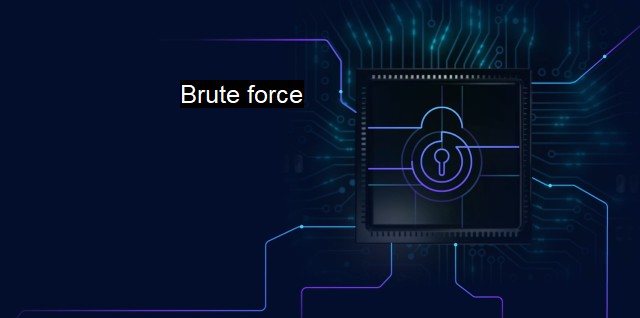What is Brute force?
Understanding Brute Force Attacks and How to Protect Against Them: Exploring the Concept, Working Process, and Antivirus Technologies
"Brute Force" is a term often encountered specifically in the context of password cracking and digital security checks. It is a widely-used cyber-attack approach, referred to as an exhaustive key search or brute force attack, that involves systematically checking every possible permutation of a password until the correct one is identified and access granted. the perpetrator is employing sheer computational force, an abundance of guesses, in the hopes that they can crack the code and access a system.Traditionally, such a method would have been incredibly labor-intensive and time-consuming, rendered less viable by the potentially astronomical amount of possible password variations. with the advent of contemporary computing power and specially designed software, a brute force execution can be automated, with a reported password cracking capacity of billions every second depending on the type and power of the computational hardware.
Intruders initiating a brute force attack would often utilize a couple of commonly employed techniques as they attempt to crack the encryption or gain unauthorized access to a system account. One such strategy is the so-called "dictionary attack". Named as such because it employs a massive set of prearranged guesses, which are often compiled from pages on the internet and do not exclude entries fitting the profile, style or language of the targeted individual.
Another popular approach is the somewhat more sophisticated 'rainbow table attack', additionally time-consuming and computationally expensive, where the attacker effectively matches the cryptographic hash function with a previously computed table of hash values. This replicates the process an antivirus utility would perform when identifying malicious code inappropriately disguised as legitimate software by matching its hash value against known virus hash values.
As worrisome as they might appear, brute force attacks aren't foolproof. Considerable sophisticated computational power is essential and the success rates aren’t firmly guaranteed. If the password or encryption key is highly complex and possesses a large number of possible combinations, and the target system has adequate safeguards in place such as account lockouts or delays after a number of failed attempts, or even an alert mechanism to a system or security administrator, the potential utility of such an attack diminishes significantly.
Besides, the growing popularity of two-factor or multi-factor authentication measures, whereby an additional level of proof of identity is needed beyond just the password, provides an extra measure of security. Also, cryptographic systems often incorporate protections methods designed specifically to counter brute force, such as adding time delays between password attempts, or even locking the system or account after a predefined number of unsuccessful attempts.
Note that detection is possible for these brute force attacks. Specific behaviours can indicate such an attack is underway, such as an abnormally high number of failed logins during a short timeframe or multiple rapid-fire requests coming from a single IP address.
Antivirus software can play a critical role in stopping brute force attacks. Advanced antivirus solutions not only provide defenses against known viruses and other malicious software but can also feature utility enhancements to craft bespoke firewall rules, malicious traffic masking or detection, and network traffic filtering to counter brute force and other cybersecurity threats.
'Brute Force' forms part of an array of security threats in the realm of cybersecurity. By understanding these attacks and adopting protective measures, individuals and organizations can ensure comprehensive protection against these persistent threats. Innovations in antivirus software and cryptographic practices, along with vigilance, play a key role in such endeavours.
Though, like the sturdy lock on the front door, the security is determined by password complexity and diversifying split authentications on an individual level. We inhabit the digital village where securing assets call for individual etiquette and collective will. In a world ridden by ruthless hackers, embodying a security-first mindset and staying privy to possible threats would enable us to fortify our digital fences and safeguard our treasured data from brute force breaches.

Brute force FAQs
What is brute force in cybersecurity?
Brute force refers to a hacking technique that involves trying all possible combinations of passwords or encryption keys until the correct one is found.What are some common examples of brute force attacks?
Password cracking, encryption key cracking, and network scanning are some common examples of brute force attacks.How can I prevent brute force attacks on my computer?
To prevent brute force attacks, you can use strong and unique passwords, implement two-factor authentication, limit login attempts, and regularly update your software and security patches.Can antivirus protect against brute force attacks?
Antivirus software may not directly protect against brute force attacks, but it can detect and remove malware that hackers use to carry out such attacks. It's important to use reputable antivirus software and keep it up-to-date to stay protected.| | A | | | B | | | C | | | D | | | E | | | F | | | G | | | H | | | I | | | J | | | K | | | L | | | M | |
| | N | | | O | | | P | | | Q | | | R | | | S | | | T | | | U | | | V | | | W | | | X | | | Y | | | Z | |
| | 1 | | | 2 | | | 3 | | | 4 | | | 7 | | | 8 | | |||||||